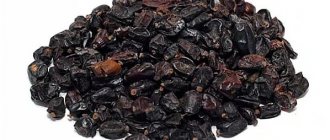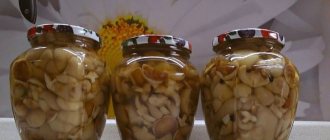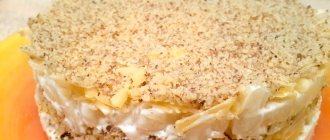Starch (rice, potato or corn) is used as an additive to give creams, sauces, liquid fillings or jelly a thicker consistency, and in baked goods (dough) and cutlets it is used as a substitute for the main product - flour or meat. Another reason for replacing starch with other products may be a simple desire to experiment with new products. But at the same time, starch gives dishes a damp taste and significantly reduces taste. It contributes to the appearance of a bland, inexpressive taste. In addition, it may well turn out that starch is an allergen for household members or guests. So, don't get too carried away adding it to recipes.
How to replace starch in cream
Starch is often used to thicken the cream for cakes. But its damp taste and reduction in the taste of sweet creams are often undesirable. With success in creams, this product can be replaced with the following products:
- Semolina.
This is the most equivalent replacement. When preparing sweet creams for cakes, replace starch with semolina. At the same time, it is pre-boiled at the rate of ½ liter of milk, 80 g of semolina and 40 g of sugar, 1 tsp. lemon zest (not including sugar for the recipe). And then the cream is prepared in the same way as with starch. - Gelatin
. When replacing starch with gelatin, remember that dry gelatin is diluted according to the instructions on the package, but the finished solution is added to the fully prepared cream, and applied to the cake only after it has completely cooled. This type of cream is only suitable for decorating with pieces or it is poured into molds along with cakes. - Coconut flakes.
If you use ground shavings, you can make an unusual cream with a refined taste. However, it should be remembered that its preparation time will increase significantly (the chips will take longer to dissolve). Add it to the finished cream, the ratio will depend on the thickness of the cream (about 2-3 tablespoons per 1 liter of cream).
What is used as a substitute in pie fillings and other baked goods?
In pie fillings, starch is used to add thickness. It is important here that the filling does not spread. You can notice it:
- Eggs.
Raw chicken eggs are good in meat, potato and vegetable fillings. - Flour.
It is used in almost any type of filling, both salty and sweet. Most often they use regular wheat flour, but you can also use corn, buckwheat, oatmeal or any other flour. Wheat has no aftertaste, and the filling will have a rich flavor of its own. When using other types, remember the additional flavor notes that flour will add to the filling. It is added without water. Place 4-5 tbsp per 1 kg of filling. - Mankoy.
This is a universal thickener without much additional flavor. It is added dry to the fillings (without diluting or brewing). The calculation will depend on the thickness of the filling. Be guided by the amount of juice or water (for ½ kg of filling you need about 3-4 tbsp). - Ground coconut.
This ingredient is added to sweet fillings. It swells, and its quantity should not exceed 1 tbsp. l. for 200g filling.
What do they put in cutlets instead of starch?
It is better to put flour in the cutlets .
At the same time, using different types of flour (oatmeal, buckwheat, corn) you can get an unusual flavor of a familiar dish.
Flour should be added in the same proportions as starch. You can also replace starch with raw, finely grated potatoes
, but there will actually be no replacement here. Since it contains the same starch.
How to thicken the sauce
The main rule for sauces is that they must have the consistency of thick sour cream and a starch thickener is added. Here its proportions depend on the thickness of the almost finished sauce. Instead of starch, several types of products are put into the sauce:
- Flour
(wheat, oatmeal, buckwheat or pumpkin, other types are also possible), after diluting it with a small amount of cold boiled water, add it at the end of cooking. - Ground flaxseed.
Dilute with cold water before adding, be sure to boil for several minutes. - Sour cream (heavy cream)
. Add carefully over very low heat, stirring all the time and not letting it boil.
The main condition for successfully adding any thickener to sauces is low heat and constant stirring.
Wheat flour
Wheat flour is made by grinding wheat into a fine powder.
Unlike cornstarch, wheat flour contains protein and fiber as well as starch. This means you can substitute cornstarch for flour, but you will need more to achieve the same effect.
As a general rule, it is recommended to use twice as much white flour as cornstarch for thickening. So, if you need 1 tablespoon of cornstarch, use 2 tablespoons of white flour.
Brown and whole wheat flours contain more fiber than white flour, so while you can try thickening with this flour to get the same result, you'll likely need much more.
To thicken dishes with wheat flour, first mix it with a little cold water to form a paste. This will prevent it from sticking and forming lumps when you add it to the recipe.
If you use wheat flour as a substitute for cornstarch, remember that it contains gluten, so it is not suitable for people with celiac disease.
Summary:
Wheat flour is a quick and easy substitute for cornstarch. For best results, it is recommended to use twice as much flour as cornstarch.
Starch replacement options
There are many alternatives to starch. Which option to use should be decided based on the type of baked goods you decide to pamper your household with.
What can be substituted in dough and products with cottage cheese?
In pancakes, starch can be easily replaced with eggs at the rate of 1 egg = 2 tablespoons of starch. Unless you're making diet pancakes. In this case, just add more flour.
In biscuits you can easily do without substitution, you just need to add more flour.
It needs to be sifted twice to enrich it with oxygen and then the baking will turn out no worse than with starch. You can add the same volume of ground crackers to a classic sponge cake (for cakes, rolls).
In shortbread dough, you can replace flour in an equal volume (additionally add a little baking powder or baking soda, quenched with vinegar), semolina, ground breadcrumbs, coconut flakes, previously crushed into flour.
In products with cottage cheese - casseroles, cheesecakes, filling for cheesecakes, cottage cheese donuts and pancakes, it is best to use semolina in equal quantities instead of starch. Keep in mind that when wet, semolina increases in volume. Therefore, before baking, let the finished mixture stand for a while to allow the semolina to swell.
What to use as a substitute in baking with cherries, fruits or berries
For wet fillings, oatmeal or wheat flour, ground coconut, or semolina are suitable substitutes. They are added for greater density and viscosity, so that when baking, the juice that the berries give does not flow out of the pie.
Advice! The coconut flakes add sweetness to the filling. Therefore, when replacing starch with it, reduce the amount of sugar.
Experiment with pumpkin seeds and flax seeds - they also have thickening properties. Like coconut flakes, the seeds must first be ground into flour.
Oatmeal or semolina will make the wet filling more viscous.
In custard, starch can be easily replaced with flour. Or beat the egg yolk with milk and sugar and add to the cream.
In the filling of cakes such as Bird's Milk, starch is replaced with gelatin or agar-agar. In this case, you will need 4 times more gelatin than agar-agar.
Agar-agar is taken at the rate of 0.9 g of powder per 100 ml of neutral liquid specified in the recipe or 1.3 g per 100 ml of acidic liquid. The mixture must be soaked, brought to a boil and cooled to the desired temperature. At a temperature of 35-40 degrees the mixture gels. If you haven’t had time to apply it before this point, just warm it up.
Gelatin is first soaked in cold water in a ratio of 1:5 (1 tablespoon of gelatin to 5 tablespoons of water) for 20-40 minutes, then heated, stirring, to 70-80 degrees. Do not bring it to a boil under any circumstances; gelatin will lose its properties. After this, cool and stir into the cream.
For buttercream, you can cook liquid but quite viscous semolina porridge in milk, cool and beat together with butter.
Advice! If you have doubts about which specific product to replace starch in this or that case, ask yourself the question: how appropriate this product will be in the product and act boldly.
Arrowroot
Arrowroot is a starchy flour obtained from the roots of tropical plants of the genus Arrowroot.
To make arrowroot, the plant's roots are dried and then ground into a fine powder that can be used as a thickener in cooking.
Some people prefer arrowroot to cornstarch because it contains more fiber (,).
It also forms a clear gel when mixed with water, making it great for thickening clear liquids ().
For similar results, it is recommended to use twice as much arrowroot as cornstarch. Arrowroot is also gluten-free, making it suitable for people who do not eat gluten.
Summary:
Arrowroot flour is a gluten-free substitute for cornstarch. You should use twice as much arrowroot as cornstarch.
White light powder
In order to determine what starch can be replaced with, you need to understand what it is used for. And this ingredient is needed to complete a task that is quite simple, but at the same time extremely important. The use of starch when preparing flour dishes is necessary to remove excess liquid, which can not only adversely affect the taste of baked goods, but also noticeably spoil its appearance, which, of course, no housewife will like. In addition, it is this ingredient that gives the dough that special ductility, which allows the production of products of various shapes and consistencies.
Potato starch
Potato starch is another substitute for cornstarch. It is made by crushing potatoes to release their starch and then drying them into powder.
Like arrowroot, potato starch is gluten-free. However, it is a refined starch, which means it is high in carbohydrates and has very little fat or protein.
Like other tuberous and root starches, potato starch has a fairly mild flavor, so it won't add any unwanted flavor to your recipes.
You should replace corn starch with potato starch in a 1:1 ratio. This means that if your recipe calls for 1 tablespoon of cornstarch, replace it with 1 tablespoon of potato starch.
It's also worth noting that many cooks recommend adding root or tuber starches, such as potato or arrowroot, later in the cooking process.
This is because they absorb water and thicken much faster than grain-based starches. Heating them too long will completely destroy them, causing them to lose their thickening properties.
Summary:
Potato starch is a great substitute for cornstarch because it has a mild flavor and is gluten-free.
What can you replace cornstarch with?
And now the main question: is it possible to interchange all the types of starch listed above? Answer: yes and no. It depends on what you cook. If we are talking about preparing gravy for meat, then, theoretically, you can replace the corn or tapioca starch called for in the recipe with more affordable potato starch. But it will still be better if you replace the corn starch with wheat flour, and the tapioca starch with potato starch, since this way you will at least replace the ingredients with more homogeneous ones and get a more or less similar result. But in some cases, replacement is impossible: if you risk it, the finished dish will most likely be ugly, or even simply inedible. For example, when marinating chicken in Chinese cuisine, you cannot replace corn starch with potato starch or flour - the result will be extremely unsightly.
But tapioca starch can be used instead of corn starch for the same purposes - then the chicken in sweet and sour sauce will be more glossy, shiny, and the sauce will be more transparent. Also, you should not replace tapioca starch, which is used in making homemade rice noodles, with potato starch - the noodles will turn out so dense and tough that you most likely will not be able to eat them. Or, various Thai/Chinese puddings: tapioca starch works best for them. It will give the necessary texture and the absence of a pronounced taste of its own. In this case, it is better to put corn starch on a shelf.
Tapioca
Tapioca is a processed starch extracted from cassava, a root vegetable found throughout South America.
It is made by grinding cassava roots into a pulp and filtering their starch-rich liquid, which is then dried into tapioca flour.
However, some cassava plants contain cyanide, so the cassava must be processed first to ensure its safety ().
Tapioca can be purchased as flour or flakes and is also gluten-free.
Most cooks recommend replacing 1 tablespoon cornstarch with 2 tablespoons tapioca flour.
Summary:
Tapioca is a processed starch flour made from the cassava root vegetable. You should replace each tablespoon of cornstarch with about 2 tablespoons of tapioca flour.
Why is starch added to dough or filling?
The use of starch in baking is explained by its two main properties - thickening and removing excess moisture.
According to professionals, replacing 30% of flour with wheat starch in baked goods increases their softness and reduces fat consumption by 17-20%.
Starch makes biscuit dough drier and airier, cookies more “sandy” and crumbly, it replaces eggs in diet pancakes, and is added to berry and fruit fillings for viscosity and density.
Cornstarch is best for biscuits and casseroles
Which starch is better - corn or potato starch?
In many cases, potato starch can be replaced with corn starch, and vice versa. Although more often potato starch is used in savory dishes, and corn starch is used in desserts. This is due to their taste.
When replacing 1st. a spoonful of potato starch is replaced with 2 tbsp. spoons of corn. The fact is that potato starch is more viscous. If you cook jelly from the same amount of potato and corn starch, then the first option will turn out viscous and transparent, while the second option will make it more like a cloudy compote.
Important! Starch to some extent “detasts” the dishes to which it is added. Therefore, the product requires more flavoring additives. When replacing starch with another product, reduce the amount of additives.
Potato starch is most often used for shortcrust pastry and jelly.
Rice flour
Rice flour is a powder made from finely ground rice. It is often used in Asian cultures as an ingredient in desserts, rice noodles, or soups.
It is gluten-free and is therefore also popular among people with celiac disease as a substitute for regular wheat flour.
Rice flour can also act as a thickening agent in recipes, making it an effective substitute for cornstarch.
It is also colorless when mixed with water, so it can be especially useful for thickening clear liquids.
As with wheat flour, it is recommended to use twice as much rice flour as cornstarch to get the same result.
It can be used with hot or cold water to make pasta or in a roux, which is a mixture of flour and fat.
Summary:
Rice flour is colorless when added to a recipe, so it can be used to thicken clear liquids. Use twice as much rice flour to get the same result.
Curd casserole with semolina - video
Of course, not all of the products listed will fully replace starch. But if everything is done correctly, the difference will not be significant.
If you don't know how to replace starch in baking, then you've definitely come to the right place! The role of a thickener in desserts is often assigned to starch, but not only this powder is used by experienced chefs for their dishes. I will share with you secrets that will help you get out of the difficult situation associated with the lack of the necessary ingredient.
Some housewives know firsthand about the contraindications of certain thickeners, including starch, which is produced from potato tubers.
Ground flax seeds
Ground flax seeds absorb liquid very well and form a jelly when mixed with water.
However, the consistency of ground flax seeds can be a little grainy, unlike cornstarch.
However, flax seeds are an excellent source of soluble fiber, so using ground flax seeds instead of flour can increase the fiber content of your dish ().
If you are making a thicker dish, you can try replacing the cornstarch by mixing 1 tablespoon ground flax seeds with 4 tablespoons water. This should replace about 2 tablespoons of cornstarch.
Summary:
You can mix ground flax seeds with water and replace the cornstarch with it. However, it may have a grainy texture and will not provide the same smoothness.
A worthy alternative to starch
The above functions can be “entrusted” to the following ingredients: chicken eggs,
- wheat, buckwheat or rye flour,
- coconut flakes,
- manke,
- oatmeal
- gelatin.
For example, in biscuit dough, starch is successfully replaced with wheat flour, which, as is known, also contains starch.
When mixing pancakes and pancakes, use chicken eggs (proportion: 1 egg instead of 1 tablespoon of starch), which hold the dough together and prevent it from spreading
Shortbread dough will turn out great with an alternative - grind semolina or dry coconut flakes into powder with a blender. Increase the number of eggs in the dough batch.
The simplest replacement for starch is the humble breadcrumbs.
Having found out what you can replace starch with in baking, stop at one of the options and test your choice in practice.
Glucomannan
Glucomannan is a soluble fiber in powder form obtained from the roots of the Amorphophallus konjac plant.
It is highly absorbent and when mixed with hot water forms a thick, colorless, odorless gel.
Because glucomannan is a pure fiber, it contains no calories or carbohydrates, making it a popular cornstarch substitute for people on a low-carb diet.
It is also a prebiotic - meaning it feeds the good bacteria in your gut and can help you maintain a healthy gut ().
Additionally, a recent review found that consuming 3 grams of glucomannan per day can reduce LDL (bad) cholesterol levels by up to 10% ().
However, you are unlikely to consume as much if you use it as a thickener. This is because its thickening power is much stronger than cornstarch, so you should use much less of it.
Most people use about a quarter teaspoon of glucomannan for every 2 teaspoons of cornstarch.
It thickens at fairly low temperatures, so mix it with a little cold water before adding it to a dish to prevent it from sticking when exposed to hot liquid.
Summary:
Glucomannan is a soluble fiber that thickens when heated with water. It contains no carbohydrates and no calories, so it is often chosen by people on a low-carb diet.
Psyllium Husk
Psyllium husk is another soluble plant fiber that can be used as a thickening agent.
Like glucomannan, it is rich in soluble fiber and contains very few carbohydrates.
You will also only need a small amount in recipes, so start with half a teaspoon and gradually increase the amount.
Summary:
Psyllium husk is another type of plant-based soluble fiber. Try using a small amount instead of cornstarch to thicken.
Xanthan gum
Xanthan gum is a plant gum that is produced by fermenting sugar with the help of the bacterium Xanthomonas campestris ().
The result is a gel, which is then dried and turned into a powder that can be used in cooking. A very small amount of xanthan gum can thicken a large amount of liquid ().
It is worth noting that when consumed in large quantities, it can cause digestive problems in some people ().
However, you are unlikely to use much of it when using it as a thickener.
It is recommended to use a small amount of xanthan gum and add it slowly. Don't use too much or the liquid may become a little slimy.
Summary:
You can replace the cornstarch with an equal amount of xanthan gum as a thickening agent when cooking.
Everything ingenious is simple
If your dish does not represent the material embodiment of high culinary delights, the most ordinary eggs, which can be found in almost any refrigerator on planet Earth, can serve as an excellent replacement. The viscosity of the dough remains excellent, and the texture does not suffer at all.

Eggs are exactly what you can use to replace starch when making pancakes and pancakes. You don’t have to worry about excess moisture in the dough, and the taste of the final frying or baking product will be richer and fuller. Just one egg can replace two tablespoons of starch - this is how you can easily solve the problem of lack of ingredients.
Guar gum
Guar gum is also a plant gum. It is made from a legume called guar bean.
The outer shell of the bean is removed and the central starchy endosperm is collected, dried and ground into powder.
It is low in calories and high in soluble fiber, making it a good thickening agent (,).
Some people prefer to use guar gum instead of xanthan gum because it is usually much cheaper.
However, like xanthan gum, guar gum is a strong thickener. Start with a small amount - about a quarter teaspoon - and slowly increase until you get the consistency you like.
Summary:
Guar gum is low in calories and high in soluble fiber. It has good thickening properties, so start with a small amount and gradually increase until you reach the desired consistency.
Other thickening methods
Several other methods can also help you thicken your dishes.
These include:
- Simmer : Cooking food over low heat for a long time will help evaporate some of the liquid, resulting in a thicker consistency.
- Puréed vegetables : Puréing vegetables can thicken tomato sauce and add more nutrients.
- Sour cream or Greek yogurt : Adding these to the sauce will make it creamier and thicker.
Summary:
There are several other methods you can use to thicken the sauce, including simmering for a long time, adding pureed vegetables, and using sour cream or Greek yogurt.
Summarize
- When it comes to thickening creams, sauces, stews and soups, there are many alternatives to cornstarch.
- Moreover, many of these thickeners have nutritional properties different from cornstarch and can accommodate a variety of dietary preferences.
- If you're looking to add a little extra fiber to your recipes, are on a low-carb diet, or are simply running out of cornstarch, you should definitely consider alternative thickeners.
Tags: starch, corn
- Related Posts
- What foods contain folate (folic acid): list of foods
- 10 Foods That Increase Keratin Levels in the Body
- 8 “Good” Sugars That May Be Harmful to Your Health
« Previous entry











